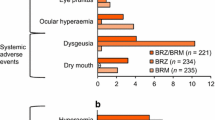Abstract
A multicenter open-label study investigated the clinical effectiveness and economic feasibility of switching 142 patients from dual therapy to twice-daily monotherapy with brimonidine for glaucoma or ocular hypertension. Evaluations were performed at baseline and 2 (visit 2) and 8 (visit 3) weeks after the switch. Patients completed a questionnaire that rated medication-related visual function and satisfaction (comfort, convenience, vision, ease of remembering to use drops) at each visit. At visit 3, investigators, taking into account IOP measurements, safety, and responses on the questionnaire, recommended whether the patient should remain on brimonidine. A pharmacoeconomic analysis, including the number of visits, cost of medication, and success rates, compared the cost of dual therapy with that of switching to brimonidine monotherapy. Of the 131 patients who completed the study, 77 (59%) had no change or a decrease in IOP from baseline, and 53 (41 %) had an increase. Investigators recommended that 77% of the study completers continue to take brimonidine monotherapy. Extending treatment with brimonidine for 12 months would achieve a significant cost savings of 16%. Brimonidine monotherapy is an efficacious and cost-effective alternative to dual therapy for glaucoma and ocular hypertension. Appropriate monotherapy may be as effective as dual therapy for many patients, and a clinically relevant trial such as this may be economically advantageous for testing a switch.
Similar content being viewed by others
References
Hoyng PF, van Beek LM. Pharmacological therapy for glaucoma: a review.Drugs. 2000;59:411–434.
Boger WP. Shorterm “escape” and longterm “drift”. The dissipation effects of the beta adrenergic blocking agents.Surv Ophthalmol Suppl. 1983;28:235–240.
Gandolfi SA. Restoring sensitivity to timolol after long-term drift in primary open-angle glaucoma.Invest Ophthalmol Vis Sci. 1990;31:354–358.
Gandolfi SA, Vecchi M. Serial administration of adrenergic antagonist and agonist (“pulsatile therapy”) reduces the incidence of long-term drift to timolol in humans.Invest Ophthalmol Vis Sci. 1996;37:684–688.
Krieglstein GK. A follow-up study on the intraocular pressure response of timolol eye drops.Klin Monatsbl Augenheilkd. 1979;175:627–633.
Jackson J. Economics and cost-effectiveness in evaluating the value of cardiovascular lipidlowering therapies: an industry perspective.Am Heart J. 1999;137:S105-S110.
Katz LJ. Brimonidine tartrate 0.2% twice daily vs timolol 0.5% twice daily: 1-year results in glaucoma subjects.Am J Ophthalmol. 1999;127:20–26.
Melamed S, David R. Ongoing clinical assessment of the safety profile and efficacy of brimonidine compared with timolol: year-three results.Clin Ther. 2000;22:103–111.
Javitt JC, Schiffman RM. Clinical success and quality of life with brimonidine 0.2% or timolol 0.5% used twice daily in glaucoma or ocular hypertension: a randomized clinical trial.J Glaucoma. 2000; 9:224–234.
Lee DA, Gornbein J, Abrams C. The effectiveness and safety of brimonidine as mono-, combination, or replacement therapy for patients with primary open-angle glaucoma or ocular hypertension: a post hoc analysis of an open-label community trial.J Ocul Pharmacol Ther. 2000;16:3–18.
Simmons ST, Samuelson TW. Comparison of brimonidine with latanoprost in the adjunctive treatment of glaucoma.Clin Ther. 2000;22:388–399.
Lee DA. Efficacy of brimonidine as replacement therapy in patients with open-angle glaucoma or ocular hypertension.Clin Ther. 2000;22:53–65.
Cramer JA, Spilker B. Pharmacoeconomics. In:Quality-of-Life and Pharmacoeconomics. Philadelphia: Lippincott-Raven; 1998:221.
1999 Drug Topics® Red Book®. Montvale, NJ: Medical Economics Co.
Sommer A, Tielsch JM, Katz J, et al. Relationship between intraocular pressure and primary open angle glaucoma among white and black Americans. The Baltimore Eye Survey.Arch Ophthalmol. 1991;109:1090–1095.
Everitt DE, Avorn J. Systemic effects of medications used to treat glaucoma.Ann Intern Med. 1990;112:120–125.
Head A, Kendall MJ, Ferner R, Eagles C. Acute effects of beta blockade and exercise on mood and anxiety.Br J Sports Med. 1996;30:238–242.
Vold SD, Wiggins DA, Jackimiec J. Cost analysis of glaucoma medications.J Glaucoma. 2000; 9:150–153.
Sverrisson T, Gross R, Pearson J, Rusk C, Adamsons I. The dorzolamide/timolol combination versus timolol plus pilocarpine: patient preference and impact on quality of life.J Glaucoma. 1999;8:315–324.
Schenker H, Maloney S, Liss C, Gormley G, Hartenbaum D. Patient preference, efficacy, and compliance with timolol maleate ophthalmic gel-forming solution versus timolol maleate ophthalmic solution in patients with ocular hypertension or open-angle glaucoma.Clin Ther. 1999;21:138–147.
Author information
Authors and Affiliations
Rights and permissions
About this article
Cite this article
Abelson, M.B., Netland, P.A. & Chapin, M.J. Switching patients with glaucoma or ocular hypertension from dual therapy to monotherapy: Evaluation of brimonidine as a model. Adv Therapy 18, 282–297 (2001). https://doi.org/10.1007/BF02850198
Issue Date:
DOI: https://doi.org/10.1007/BF02850198




